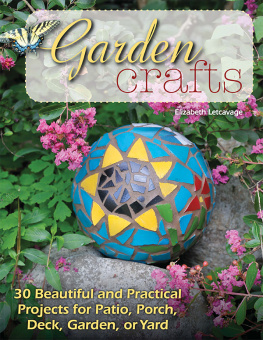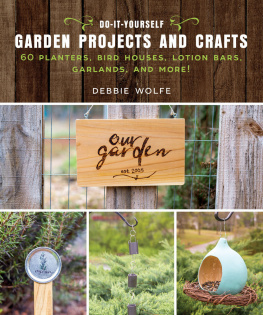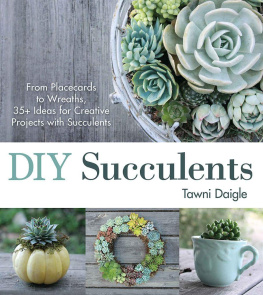
PLANT CRAFT
PROJECTS THAT ADD NATURAL STYLE TO YOUR HOME
CAITLIN ATKINSON



Contents
PREFACE
As a child I would help my mother pick flowers from our garden in summer and make bouquets in the cool of the early morningmy first exposure to the pleasures of working with plants. I loved summer and all the botanical wonder it brought. We lived on a farm, and when I wasnt in the garden I was often reading in the meadow or climbing trees. My life was spent outdoors, only coming in when too cold or wet. The land influenced me profoundlyseasons, light, weather, and topography lead me to new discoveries and creative endeavors. Throughout my life Ive continued to feel the need to connect with the natural world. While living in San Francisco, in order to satisfy my desire to bring more green into my home, I began creating indoor garden projects. I have since moved and now have outdoor space, but I continue to bring the outdoors in.
Im a photographer by trade, and my photography skills, along with my experience working as a stylist on photo shoots and a merchandiser at an urban garden shop, inform the aesthetics of the projects in these pages. The principles of balance in color choices, in texture combinations, and of creating a space for the viewer to enter a composition all draw on the same set of visual tools and apply to crafting and design as well as photography.
If you live in an urban environment these projects offer a way to connect with nature within the confines of a city. Not everyone can afford a rooftop garden or even a terrace, but everyone can make a little garden of their own indoors. If you have outdoor space, there is something invigorating about extending that green space indoors.
There is a project for everyone in this book. Create a colorful floral wall mural, an elegant table centerpiece, a serene underwater sculpture, or a whimsical mobile to suspend from the ceilingeach is a work of art inspired by the natural world.

Epiphytes are ideal plants for wall gardens. This one uses vanilla orchids, a personal favorite.

Dried botanicals make a beautiful wall display.
INTRODUCTION
As any gardener can tell you, working with plants and other natural materials forces you to accept the independent nature of the subject matter. An indoor garden can inspire a sense of wonder and anticipation, but also disappointment, and the unpredictability of working with natural materials can be a source of awe and frustration. An artist or crafter working with living things is forced to accept the impermanence of her creation and life itselfit is always a learning experience, and while mistakes can be made, fun can be had.
The projects in this book range from tabletop gardens to hanging sculptures to vertical wall gardens. A few are versatile and can be displayed by securing them to a wall or perching them on a bookshelf to lean against a wall. They vary in difficultya few, like the Water Sculpture Garden, merely call for assembling the materials to create the project while others, like the Bench Planter, require basic drilling know-how and comfort using a saw. Most can be made in an hour or two. Given the right care, they all have the potential to grace your home for a long time. Some projects, such as the Miniature Flagstone Planting and the Saikei Tray Garden, are small living landscapes, which give you a chance to go beyond caring for a houseplant and fully engage your creative spirit as you select and arrange the materials and then tend to the plants.
There is no need to stop with the projects in these pagesuse this book as a starting point. Seek inspiration for ideas in your daily life: from an art exhibit, a walk through a park, or a great book. Look to what is available in your local environment as well from afar when youre thinking about a new project. Exploring your surroundings closely is a way to develop a deeper connection to the place where you live. The need to connect with something beyond ourselves is necessary, the need to create, elemental. There is no better way to harness the desire to create, connect, and enjoy nature than an indoor garden project. Go get dirty.
Materials
PLANTS, CONTAINERS, AND DECORATIVE ELEMENTS
Look to your local garden and hardware stores for supplies such as plants and containers. Secondhand shops are also an excellent resource for containers, especially unusual ones. Keep in mind that containers need to have drainage holes, so if youre purchasing an unconventional container at a secondhand shop be sure its something you can drill a drainage hole (or two) in.
If youre on the hunt for an unusual plant and dont see it at your nursery, dont forget that most nurseries and garden centers can usually special order a plant if they dont have what youre looking for in stock. You can often purchase samples or small amounts of flagstone, rocks, and gravel at your local landscape supply store. Online, Etsy is a great source for everything from handmade containers to wood.
DRIED BOTANICALS AND BOTANICAL EMULSIONS
Some of the projects in this book use dried botanicals. The key to featuring any dried botanical long-term is to display them in a place with low humidity and limit the amount of sunlight that reaches them. Preserved flowers can reabsorb water in the form of humidity and wilt. The more light in a room the faster the color in a dried botanical will fade, so it is best to display dried botanicals in a room that has low light and humidity.
The anthotype print project uses a photographic emulsion (the coating that creates the color of the print) made from botanical juice. As with dried botanicals, the more light in a room the faster the color in the print will fade, so it is best to display the anthotype prints in a room with little sunlight.
DRIFTWOOD
Prior to using driftwood you must cure it. The curing process leaches any excess tannins and salt. The best way to remove all toxins from driftwood is by boiling the wood for one to two hours. If you do not have a pot large enough to boil a piece of driftwood, you can soak the wood for two weeks, changing the water frequently. Driftwood from a lake is better than driftwood from the sea because of the amount of salt in wood from the sea. If you are using the driftwood submerged in water, such as in the Driftwood Water Garden, you may see some discoloration in the water after the curing process. The discoloration means that the tannins havent been completely leached out (it can take weeks or months for the tannins to completely leach out). It wont harm the plants, but if you dont like it remove the wood from the vase and soak it some more until the water is clear.
Next page




![Atkinson - An army at dawn: [the war in North Africa, 1942-1943]](/uploads/posts/book/178818/thumbs/atkinson-an-army-at-dawn-the-war-in-north.jpg)











